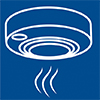FPA DEVELOPS NEW FIRE COMPARTMENTATION AND DOOR SURVEY TECHNOLOGY
FPA DEVELOPS NEW FIRE COMPARTMENTATION AND DOOR SURVEY TECHNOLOGY
The FPA’s expert surveyors have been conducting comprehensive, non-destructive fire compartmentation surveys and delivering detailed reports for several years. We are delighted to announce that we have recently developed new technology to significantly improve the outputs for our customers.

New technology benefits
Using a tablet device, our software application enables our surveyors to upload building floor plans which are used to describe the compartmentation strategy, and identify the location of each fire door and any identified compartmentation issue/breach. Each issue is given a unique ID number on the drawing which corresponds with the digital survey report. A RAG rating is also included to enable the prioritisation of remedial works.
This technology enables us to produce a clear, concise, comprehensive digital report which links any identified issues to the location on the building floor plans. Annotated drawings are provided in AutoCAD and pdf formats and the report is produced in a useable format so that clients can filter, extract, and import data into their own systems.
Our compartmentation survey outputs comprise:
- > annotated plans of each building floor showing the lines of compartmentation
- > details of each compartmentation breach, hole, and imperfection identified with suggested repair detail
- > a thorough review of all elements of each fire door and remedial actions described using the BM TRADA Accepted Repair Techniques
- > actual or expected damper locations
- > any obvious fire hazards or risks
- > rough order costs for each issue (if required).
This new technology can also be used to carry out fire door inspection surveys as a discrete activity.
FPA Director of Operations and Principal Consultant, Howard Passey said: “We’re really pleased to have reinvigorated the way in which we carry out our compartmentation surveys and fire door inspections through the development of this technology. It offers considerable improvements for our clients as it makes the process of carrying out the surveys quicker, and therefore more cost effective. The outputs are also more comprehensive and more user friendly, and I look forward to our clients reaping the benefits.”
Find out more about our new compartmentation survey and fire door inspection technology.
Article originally published by the Fire Protection Association, FPA Media, 6 July 2022 © COPYRIGHT THE FPA 2022
RES are members of the FPA











;)
